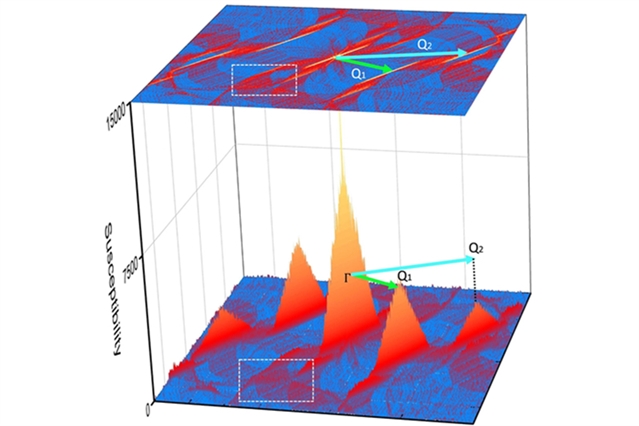
美国普林斯顿大学M. Zahid Hasan和新加坡南洋理工大学Guoqing Chang研究组取得一项新突破。他们发现了可调谐拓扑驱动费米弧范霍夫奇点。该项研究成果发表在2023年2月2日出版的《自然—物理学》上。
该团队确定了手性费米子的电子拓扑结构作为创建范霍夫奇点的驱动机制,在表面带结构中宿主电子不稳定性。研究人员观察到手性费米子导体RhSi和CoSi具有两种类型的螺旋弧范霍夫奇点,研究人员称之为I型和II型。在RhSi中,I型变体主要是在不同能量下驱动螺旋弧连接性的切换。在CoSi中,该团队在费米能级附近测量了II型螺旋内弧范霍夫奇点。化学工程方法能够调整这些奇点的能量。
最后,电子磁化率计算使他们能够可视化螺旋弧奇点的主要费米表面嵌套向量,这与最近对CoSi中表面电荷密度波排序的观察一致。这表明螺旋弧奇点与表面电荷密度波之间存在联系。
据了解,电子相的分类方案主要涉及两大范式:相关性和拓扑学。电子关联产生超导和电荷密度波,量子几何Berry相产生电子拓扑。这两种范式的交叉已经开始努力发现拓扑材料的费米能级或附近的电子不稳定性。
附:英文原文
Title: Tunable topologically driven Fermi arc van Hove singularities
Author: Sanchez, Daniel S., Cochran, Tyler A., Belopolski, Ilya, Cheng, Zi-Jia, Yang, Xian P., Liu, Yiyuan, Hou, Tao, Xu, Xitong, Manna, Kaustuv, Shekhar, Chandra, Yin, Jia-Xin, Borrmann, Horst, Chikina, Alla, Denlinger, Jonathan D., Strocov, Vladimir N., Xie, Weiwei, Felser, Claudia, Jia, Shuang, Chang, Guoqing, Hasan, M. Zahid
Issue&Volume: 2023-02-02
Abstract: The classification scheme of electronic phases uses two prominent paradigms: correlations and topology. Electron correlations give rise to superconductivity and charge density waves, while the quantum geometric Berry phase gives rise to electronic topology. The intersection of these two paradigms has initiated an effort to discover electronic instabilities at or near the Fermi level of topological materials. Here we identify the electronic topology of chiral fermions as the driving mechanism for creating van Hove singularities that host electronic instabilities in the surface band structure. We observe that the chiral fermion conductors RhSi and CoSi possess two types of helicoid arc van Hove singularities that we call type I and type II. In RhSi, the type I variety drives a switching of the connectivity of the helicoid arcs at different energies. In CoSi, we measure a type II intra-helicoid arc van Hove singularity near the Fermi level. Chemical engineering methods are able to tune the energy of these singularities. Finally, electronic susceptibility calculations allow us to visualize the dominant Fermi surface nesting vectors of the helicoid arc singularities, consistent with recent observations of surface charge density wave ordering in CoSi. This suggests a connection between helicoid arc singularities and surface charge density waves.
DOI: 10.1038/s41567-022-01892-6
Source: https://www.nature.com/articles/s41567-022-01892-6
